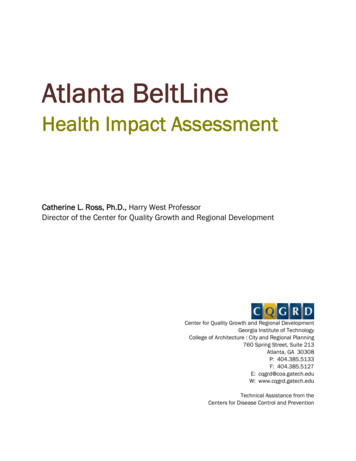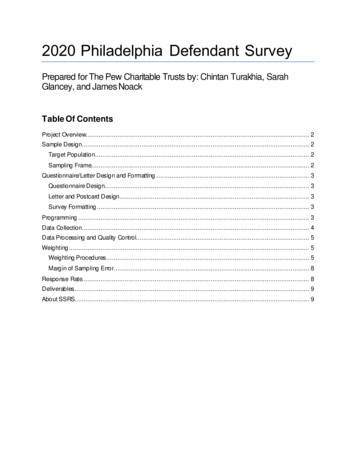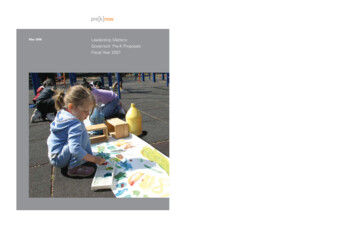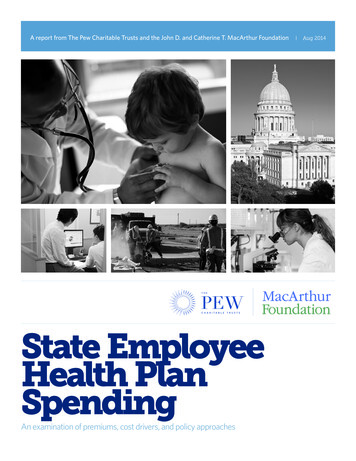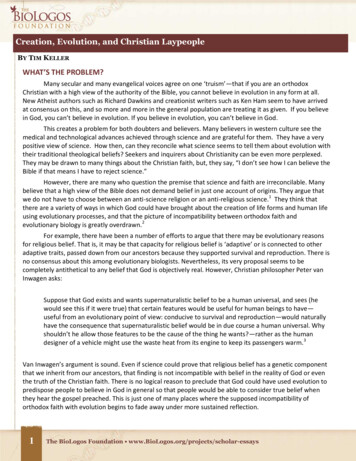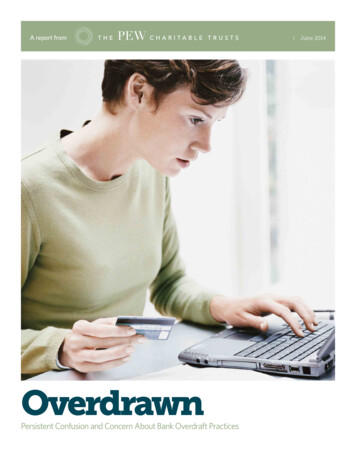
Transcription
A report fromOverdrawnPersistent Confusion and Concern About Bank Overdraft PracticesJune 2014
The Pew Charitable TrustsSusan K. Urahn, executive vice presidentTravis Plunkett, senior directorTeam membersSusan Weinstock, directorThaddeus King, senior associateBenjamin Navarro, senior associateAndrew Blevins, associateExternal reviewersThis report benefited from the insights and expertise of external reviewers Rebecca K. Borné, senior policycounsel, Center for Responsible Lending; and Mike Mokrzycki, independent survey research consultant. Neitherthey nor their organizations necessarily endorse its findings or conclusions.AcknowledgmentsThe project team for consumer banking thanks Steven Abbott, Sarah Babbage, Jennifer V. Doctors, ElizabethFuller-Wright, Alex Horowitz, Clinton Key, David Merchant, Andrea Risotto, Kristin Schulte, and Mark Wolff forproviding valuable feedback on the report; and Dan Benderly, Sara Flood, Laura Woods, and Fred Schecker fordesign and Web support. Many thanks to other former and current colleagues who made this work possible.For further information, please ct: Andrea Risotto, communications officerEmail: arisotto@pewtrusts.orgPhone: 202-540-6510The Pew Charitable Trusts is driven by the power of knowledge to solve today’s most challenging problems. Pew applies a rigorous, analyticalapproach to improve public policy, inform the public, and stimulate civic life.
Contents1OverviewSurvey Details 23Profiles of overdrafters5Awareness of overdraft5The overdraft experienceHow many Americans overdraw? 5How often do overdrafts happen? 6How much does overdraft cost a consumer? 7What transactions result in overdrafts? 8When and how are consumers informed about overdraft? 8How do overdrafts affect banking relationships? 1010Attitudes about overdraft12Overdraft opinions and behaviors by group15Recommendations16Appendix A: Methodology17Appendix B: Technical appendixModel design 17Model output 1718Endnotes
OverviewNine out of 10 Americans have a checking account, making it the most widely used financial services productin the United States.1 Overdraft programs at banks and credit unions allow checking account holders to spendor withdraw more money than they have in their accounts. In exchange, banks usually charge a fee for eachtransaction for which there are insufficient funds in an account.Consumers generally have three choices when they do not have enough funds to cover a debit card purchase orATM withdrawal: Incur an overdraft penalty fee. The bank makes a short-term advance to cover the transaction and charges afee for the service (median fee: 35).2 Incur an overdraft transfer fee. The bank transfers funds from a linked source, such as a savings account, lineof credit, or credit card, and charges a fee for the service (median fee: 10).3 Have the transaction declined. If the consumer did not opt in to one of the above options, the transaction isdenied and no fee is charged.According to the federal Consumer Financial Protection Bureau, these programs “evolved from a manual courtesyprogram to an automated feature that today generates a significant share of financial institutions’ revenue fromdeposit accounts.”4 In fact, according to one estimate, financial institutions collected 16.7 billion in overdraft feesfor 2011, at least 5.8 billion of which was triggered specifically by a debit card purchase or ATM withdrawal.5Another estimate projected 32 billion in overdraft and insufficient funds revenue in 2012.6Among other provisions, Regulation E, which implements the Electronic Fund Transfer Act and was revised in2010, requires that financial institutions obtain affirmative consent (“opt in”) from consumers before enrollingthem in an overdraft penalty plan that covers debit card transactions at the point of sale (whether at a cashregister, online, or over the phone) or at an ATM. The CFPB is responsible for implementation of Regulation E andenforcement of the opt-in rule.7To better understand the experience of consumers who overdrew using their debit card during 2013, The PewCharitable Trusts commissioned a survey of checking account holders.8 The study found that these consumerswere often confused and unhappy.9 These findings are similar to those in Pew’s 2012 issue brief “OverdraftAmerica: Confusion and Concerns About Bank Practices.”10This brief delves into the 2013 results and looks at how they relate to those from 2012 when comparisons arepossible. Specifically, the key 2013 survey findings are: Younger, lower-income, and nonwhite account holders, as well as those who did not have a credit card, areamong those who were more likely to pay an overdraft penalty. More than half of those who incurred a debit card overdraft penalty fee do not believe that they opted in tooverdraft coverage. 10 percent of Americans paid at least one overdraft penalty fee in 2013, and another 5 percent paid anoverdraft transfer fee. On average, people who paid an overdraft penalty also incurred additional fees, for a total of 69 the last timetheir account was overdrawn. 13 percent of people who paid an overdraft penalty say they no longer have a checking account; 19 percentreport responding to overdraft fees by discontinuing overdraft coverage; and 28 percent report closing achecking account in response to overdraft fees.1
More than three-quarters of the people who paid an overdraft penalty fee express concern about specificoverdraft policies, including the high cost of a penalty and the practices of charging “extended” overdraftfees—additional charges for failing to repay a negative balance on time—and of reordering withdrawals fromhighest to lowest dollar amount, which have the effect of increasing overdraft fees. Large majorities of those who paid an overdraft penalty prefer that a transaction be declined rather thanoverdraw an account, and they support greater regulation of overdraft products. Four groups of consumers surveyed—“overdrafters,” “transferers,” “decliners,” and “never-negatives” (see “SurveyDetails” sidebar)—express similar concerns about overdraft policies, in spite of their differing experiences.Pew urges the CFPB to require financial institutions to make overdraft programs safer and more transparent byensuring that consumers understand their options for overdraft coverage. Although clear disclosure is important,the CFPB should also prohibit the practice of transaction reordering that maximizes overdraft fees and ensurethat fees are reasonable and based on the actual cost to the bank of providing the service.Survey DetailsIn December 2013, Pew completed a nationally representative survey of American adults to ask about theirexperiences with debit card and ATM overdrafts and explore account holder knowledge, understanding, andattitudes about overdraft fees.* A total of 1,804 consumers were interviewed.†Using the survey data, Pew examined the most common characteristics of overdrafters, revealing the traitsmost associated with paying overdraft fees. The data also reveal several areas in which American consumersare confused, dissatisfied, and caught off guard by banks’ overdraft policies and practices.This survey is a follow-up to a survey completed in April 2012 that was summarized in “Overdraft America.”‡ Thesecond iteration of the survey collected much of the same information as in 2012 as well as answers to a handfulof new questions. However, unlike the 2012 study, which completed interviews only with consumers who hadexperienced a recent overdraft, the 2013 survey interviewed three additional groups of respondents. Specifically,based on the survey results, Pew grouped respondents into four categories based on their overdraft status in 2013:Overdrafters: Paid an overdraft penalty fee for a debit card transaction.§Transferers: Paid an overdraft transfer fee for a debit card transaction.**Decliners: Had a debit card transaction declined instead of paying an overdraft fee.††Never-negatives: Never completed a debit card transaction that would have resulted in a negative accountbalance or had a transaction declined for insufficient funds.‡‡* On behalf of Pew, Social Science Research Solutions, as part of a larger omnibus survey conducted Oct. 30, 2013, to Dec. 15, 2013, askedconsumers about their experiences with overdraft programs.† The margin of error is plus or minus 2.31 percentage points at the 95 percent confidence level.‡ The Pew Charitable Trusts, “Overdraft America: Confusion and Concerns about Bank Practices” (May 2012), http://www.pewtrusts.org/ /media/Imported-and-Legacy/uploadedfiles/pcs assets/2012/SCIBOverdraft20America1pdf.pdf.§ 671 overdrafters constitute 10 percent of the sample. The margin of error is plus or minus 3.78 percentage points at the 95 percent confidence level.** 319 transferers constitute 5 percent of the sample with a margin of error of plus or minus 5.49 percentage points at the 95 percent confidence level.†† 203 decliners constitute 3 percent of the sample with a margin of error of plus or minus 6.88 percentage points at the 95 percent confidence level.‡‡6,849 never-negatives constitute 83 percent of the sample. Of those, 611 were interviewed with a margin of error of plus or minus 3.96 percentagepoints at the 95 percent confidence level.2
Profiles of overdraftersAs a group, overdrafters differ from the broader U.S. population. Several traits are related to a higher probabilityof being an overdrafter. Figure 1 presents the most noteworthy relationships; the full list of significantrelationships that we measured is presented in Appendix B. These results, however, should not be understood toimply that any characteristic causes overdrawing.Figure 1Young and Lower-income Consumers Are Among Those MostLikely to OverdrawA 25-year-old is.% more likely to pay an overdraft133The young are more likely to payan overdraft penalty than theirolder counterparts. A 25-year-old is133 percent more likely to pay anoverdraft fee than a 65 year old.Consumers earning lessthan 100,000 are.% more likely to pay an overdraft105penalty fee than those earning 100,000or more.Consumers earningless than 100,000 are 105 percent morelikely to pay an overdraft penaltyfee than those earning 100,000or more.Nonwhites are.Consumersearningless thanwho have a credit cardNonwhites are83 percentmoreConsumersearningthan Consumers 100,000arean105percentlessmoreare 34 percent less likely to pay anlikely to payoverdraftpenaltymorelikely to pay an overdraft 100,000arean105percentmoreoverdraft penalty feelikelyto payoverdraftpenaltythosefee seearning 100,000penaltyfee than whites.likely to pay an overdraft penaltyor more.fee than those earning 100,000or more.83Nonwhites are 83 percent morelikely to pay an overdraft penaltyfee than whites.hites are 83 percent moreo pay an overdraft penaltyn whites.percent moreerdraft penaltyConsumers earning less than 100,000 are 105 percent morelikely to pay an overdraft penaltyfee than those earning 100,000or more.The young are more likely to payan overdraft penalty than theirolder counterparts. A 25-year-old is133 percent more likely to pay anoverdraft fee than a 65 year old.ung are more likely to payrelikelyto thanpaytheirrdraftpenaltyy than theirounterparts.A 25-year-old isrcentmore likely to ispay anA 25-year-oldaft fee than a 65 year old.likely to pay ana 65 year old.penalty fee than a 65-year-old.Consumers who have a credit cardare 34 percent less likely to pay anoverdraft penalty fee than thosewho do not have a credit card.Consumers who have a credit cardare 34 percent less likely to pay anConsumerswhooverdraftpenalty fee thanthosehave awhodo not havea creditcard.creditcardare.34%less likely to pay an overdraftpenalty fee than those who do nothave a credit card.Consumers who have a credit cardare 34 percent less likely to pay anoverdraft penalty fee than thosedoCharitablenot havea credit card. 2 014whoThe PewTrusts3
Table 1 presents the demographic characteristics of overdrafters as well as the U.S. population, withoutcontrolling for any variables.Table 1Overdrafters vs. U.S. Population, by Demographic Characteristic abledRetiredHomemakerStudentIncome Less than 15,000 15,000 to under 25,000 25,000 to under 30,000 30,000 to under 40,000 40,000 to under 50,000 50,000 to under 75,000 75,000 to under 100,000 100,000 Don't know/refused to answer/unspecifiedWhite (non-Hispanic)African-American (non-Hispanic)HispanicOther race/ethinicityAges 18-29Ages 30-49Ages 50-64Ages 65 ParentNot a parentLess than high schoolHigh schoolSome e member of military in householdNo active member of military in householdNortheastSouthNorth-centralWest4% ofoverdrafters% ofU.S. 02619102495159418372123Note: In some cases, percentagesmay not add up to 100 due torounding or the exclusion ofrespondents who do not know orrefuse to answer a question. All dataare from the 2013 survey. 2014 The Pew Charitable Trusts
53.72%Percent of overdrafters201252.34%201352%Recall opting inAwareness of overdraft%37.792012Pew’s data continue to show that overdrafters do not fully understand the federal rule requiring that consumers%201341.13affirmativelyopt in to penalty coveragebeforebeing charged the fee. Many overdrafters express confusion anduncertainty with the product and the rules surrounding it. As in 2012, more than half do not recall agreeing tooverdraft coverage despite having paid a penalty fee, which requires the account holder’s consent.11of overdrafters do not believe that they opted in to overdraft coverage52More Than Half of Overdrafters Do Not Recall Opting In to Overdraft%Figure 2(2012-13)Percent of overdrafters54%52%38%41%52%52%2012Do not recall opting in2013Recall opting inShare of overdrafters who donot believe they opted in tooverdraft coverageNote: Respondents were asked, “As far as you know, did you choose to sign up for overdraft coverage, where you are charged a fee for eachoverdraft, or not?” 2 014 The Pew Charitable TrustsIn 2013, the majority of overdrafters (52 percent) say that they were either unaware that their bank offeredoverdraft coverage or discovered the cost of a penalty only after they had overdrawn their account.12The overdraft experienceBoth the 2012 and 2013 surveys collected information on how many Americans overdrew using their debit cardsand how often they do so. Year-over-year comparisons of responses to these questions reveal key trends andshifts. The 2013 survey, however, included a number of new questions, providing a more complete picture ofconsumers’ experience with overdraft.How many Americans overdraw?In 2013, 10 percent of American adults say they paid an overdraft penalty fee (categorized as overdrafters),5
and another 5 percent say that they paid a transfer fee (transferers).13 Compared with 2012, the percentage oftransferers held steady, but the percentage of overdrafters declined.14 (See Figure 3.)Figure 3Rate of Paying Overdraft Penalty Fees Fell (2012-13)4014OverdraftersPercentof AmericansPercentof overdrafters12351030Note: Respondents were asked, “Withinthe past year, have you been chargedan overdraft fee by your bank or creditunion for using your debit card to make apurchase or withdraw money that causedyour account to have a negative balance orbecome ��If so, was the overdraft covered by atransfer from another account you havewith the bank or credit union, or didyour checking account balance becomenegative?”4.5%%21010% 9%0520126%20130One overdraftsTwo happen?ThreeHow often doto NineTransferers10 to 19%7 3%Pew Charitable 2014 TheTrusts %2%0% 120 or MoreDon’t KnowRefusedThe majority of overdrafters in both surveysNumbersaid thatthey paid three or more penalty fees during the past year.15of overdraft penalties in past yearFigure 420122013Most Overdrafters Paid 3 or More Penalty Fees (2012-13)40Percent of overdrafters3537%30252025%24%21%35%21%151010% 9%50213-910-196%7%20 or more3%2%Don’t know0%1%RefusedNumber of overdraft penalties in past year20122013Note: Respondents were asked, “Just taking your best guess, how many times have you been charged an overdraft penalty fee in the lastyear?” 2 014 The Pew Charitable Trusts640352013201237%35%
How much does overdraft cost a consumer?In 2013, overdrafters report paying total fees averaging 69 during their most recent overdraft.16 Although themedian total reported was 35, a quarter of overdrafters paid 90 or more during their last overdraft.17 For manyoverdrafters, having a balance drop below zero resulted in more than one penalty fee.Figure 5Most Overdrafters Paid 30- 100 for Last Overdraft (2013)60Percent of overdrafters50Note: Respondentswere asked, “Thinkingabout the most recenttime during whichyour checking accountbalance was negative,about how much didyou pay in overdraftfees over the entireperiod your balance wasnegative?”52%4030201012%12%8%0Less than 30 30 to 99.99 100 to 199.99 200or more13%Don't know2% 2014 The PewCharitable TrustsRefusedTotal fees during last overdraftThe survey indicates that most overdrafters who paid a penalty fee did so for what amounts to a very short cashadvance: Seventy percent of 2013 overdrafters report that after learning about their negative balance, they wereoverdrawn for four or fewer days, and nearly a third (31 percent) regained a positive balance the same day.Figure 6Most Overdrafters Had Negative Balances for 4 or Fewer DaysDuring Last Overdraft (2013)35Percent of overdrafters302531%24%201515%1012%16%50Note: Respondents wereasked, “Thinking about themost recent time duringwhich your checking accountbalance was negative, onceyou found out about theoverdraft, how long did it takefor you to put money into theaccount and make the balancepositive? Was it ?”1%SamedayNextday2-4days5-7daysMore than7 daysDon'tknow1% 2014 The Pew CharitableTrustsRefusedLength of overdraft7
Many banks and credit unions, including a majority of large banks, charge extended overdraft fees, which areadditional charges for failing to repay a negative balance on time.18 Among the 50 largest banks that Pew studiedin 2014, the median extended fee was 8 and the median length of time triggering this fee was five days.19Eighteen percent of overdrafters surveyed in 2013 say they paid at least one extended fee.2018%Share of overdrafters who have paid an extended overdraft feeWhat transactions result in overdrafts?Several banks have instituted policies that give consumers a small negative balance cushion that preventsoverdraft fees from being charged if their accounts drop only slightly below zero.21 Nevertheless, 15 percent ofoverdrafters report that the transaction that caused their most recent overdraft was not more than 5, and amajority (63 percent) report that it was 50 or less.Figure 7Most Transactions That Caused an Overdraft Were for 50 or Less(2013)403536%30Percent of overdraftersNote: Respondents wereasked, “Thinking about themost recent time duringwhich your checking accountbalance was negative, abouthow much was the cost of theinitial transaction that causedthe overdraft?”2524%2024% 2014 The Pew CharitableTrusts1510504%Less thanor equalto 111%1% 1.01 5 5.01 20 20.01 50Morethan 50Don'tknow0%RefusedTransaction amountWhen and how are consumers informed about overdraft?Simply being unaware of an overdraft for a few days can lead to an extended overdraft fee. More than onequarter of overdrafters (26 percent) report that they learned about the overdraft five or more days after itoccurred. Moreover, 84 percent say they were not warned by their bank or credit union, before completing thetransaction, that it would overdraw their account, information that could be provided through a message screenat an ATM, for instance.228
Figure 8Most Overdrafters Did Not Learn of Overdraft for 2 or More Days(2013)30Percent of overdrafters2524%2021%Note: Respondents wereasked, “Thinking about themost recent time duringwhich your checking accountbalance was negative,how long after the initialtransaction did you learnabout the overdraft? Wasit ore than7 daysDon'tknow 2014 The Pew CharitableTrusts0%RefusedTime until account holder learned of overdraftA majority of overdrafters say they learned about their penalty through either an account statement or a noticesent by mail. Active notification methods, such as text message or email alerts, do not seem to be commonlyoffered by financial institutions or used by consumers.Figure 9Overdrafters Most Often Learned of Overdraft From AccountStatement (2013)35Percent of overdrafters302531%27%201513%108%50Account Notice sentstatementby herDon’tknow0%RefusedMethod of communicationNote: Respondents were asked, “How did you find out that your checking account had a negative balance and that your bank or credit unionwas covering the overdraft and charging a fee? Choose all that apply.” 2 014 The Pew Charitable Trusts9
How do overdrafts affect banking relationships?More than one-quarter (28 percent) of overdrafters say that they closed a checking account in the past becauseof overdrafts, down from 34 percent when asked in 2012.23 Nineteen percent say they had inquired aboutdiscontinuing overdraft service in response to fees.24 Thirteen percent report that they currently do not have achecking account.25Previous research found a relationship between incurring checking account overdraft fees and leaving the bankingsystem.26Attitudes about overdraftAt least half of 2013 overdrafters express confusion or concern about overdraft in response to every question thatprobes such attitudes. Although some specific views shifted since the 2012 survey, the general findings remainconsistent.A large majority (68 percent) continue to prefer that a transaction be declined rather than processed at the costof a penalty of “ 35 or so,” down slightly from 75 percent in 2012.2768% Share of overdrafters who prefer that a transaction be declinedrather than pay a 35 overdraft fee, in a hypothetical situationAs in 2012, the vast majority of overdrafters have strong views about overdraft policies and practices. More thanthree-quarters of overdrafters express concern about specific overdraft policies: the high cost of a penalty fee, thefee associated with “extended” overdrafts, and the process of transaction reordering: 87 percent of consumers who overdrew their accounts are somewhat or very concerned about the “ 35 or so”penalty fee; previous Pew research showed that large banks charge a median of 35 for this fee.28 83 percent of overdrafters are somewhat or very concerned about the practice by some banks of reorderingwithdrawals from highest to lowest dollar amount, which has the effect of increasing overdraft fees.29 78 percent are somewhat or very concerned about the policy of charging an extended overdraft penalty fee.Responses to these questions are similar to those from 2012, except for concern about extended overdraft feepolicies, which declined from 86 percent.10
Figure 10Overdrafters Continue to Have Strong Concerns About BankOverdraft Practices (2013)Concern:Cost 5%56%20130%20%21%22%40%8% 5%25% 6% 6%51%20137% 5%60%3%8% 6%2% 1%8% 6%13%80%8%100%Percent of overdraftersVeryconcernedSomewhatconcernedNot tooconcernedNot at allconcernedDon’tknowRefusedNotes: The 2013 figures for “Extended overdraft” do not total to 100% due to rounding.Respondents were asked, “Does that make you very concerned, somewhat concerned, not too concerned, or not at all concerned?” for each ofthese three bank overdraft practices:a. “Reordering your withdrawals in a way that makes you more likely to overdraft your account.”b. “Charging a fee of around 35 for each overdraft.”c. “Charging an extended overdraft fee of around 12.00 for not paying off the overdraft penalty on time, usually within 7 days.” 2 014 The Pew Charitable TrustsAlthough down from 2012, 50 percent of 2013 overdrafters say overdraft penalty products on debit cards hurtconsumers more than they help them. Conversely, only 41 percent say they help more than hurt.30Among 2013 overdrafters, 80 percent say these products should be more closely regulated.3180% Share of overdrafters who say overdraft practices and feesshould be more closely regulated11
Overdraft opinions and behaviors by groupIn the 2013 survey, Pew defined and interviewed four groups of consumers: overdrafters, transferers, decliners, andnever-negatives.32 Pew compared their financial behaviors and opinions about overdraft. While these groups differin many ways, including their experiences with overdraft, there are notable similarities. In particular, at least half ineach group say that overdraft hurts consumers more than it helps, prefer that a transaction be declined rather thancompleted at the cost of a penalty, and agree that overdraft products should be more closely regulated.Under Regulation E, only consumers who opt in to overdraft penalty service should be charged a penalty fee fordebit card transactions, but just 41 percent of overdrafters report opting in. This means nearly two-thirdsof overdrafters either do not remember or incorrectly recall whether they had opted in, casting doubt on theclarity of current disclosures and raising questions about how the service is marketed. Further, 58 percent oftransferers, 30 percent of decliners, and 21 percent of never-negatives say they opted in to overdraft coverage ontheir debit card.In addition, large majorities of all groups are more likely, when presented with a hypothetical situation, to preferthat their transactions be declined rather than incurring an overdraft penalty fee: decliners, 81 percent; nevernegatives, 77 percent; transferers, 70 percent; and overdrafters, 68 percent.Figure 11Across Groups, More Than Two-thirds of Overdrafters Prefer aDeclined Transaction Over the 35 Fee (2013)Percent of respondents by TransferersDecliners14%Never-negativesGroupPrefer transaction declinePrefer transaction completed with 35 feeNote: Respondents were asked, “Pretend for a moment that you are at a store about to use your debit card to make a purchase and that youare unaware there is not enough money in your checking account to cover that purchase, would you rather ” 2014 The Pew Charitable TrustsAmong consumers from all groups who opted in to an overdraft penalty program, most also say they would preferthat a transaction be declined rather than pay a penalty fee. Although preferences may change over time, thisseems to indicate that consumers are confused about opt-in decisions, regardless of overdraft category.12
Figure 12Across Groups, Even Those Opting In Prefer Decline to Overdraft56%ofoverdrafters68%75oftransferers68% of%declinersof nevernegativeswho recall opting into an overdraft penalty program wouldprefer that transactions be declined rather than processed witha 35 overdraft penalty fee.By large margins, all groups agree that overdraft fees and practices should be more closely regulated: 80 percentof overdrafters, 78 percent of transferers, 77 percent of decliners, and 63 percent of never-negatives agree withthis sentiment.Figure 13Across Groups, Large Majorities Support More Overdraft Regulation(2013)90Percent of respondents by upport greater negativesOppose greater regulationNote: Respondents were asked, “Do you think that bank and credit union overdraft practices and fees should be more closely regulated, or not?” 2 014 The Pew Charitable Trusts13
At least half of respondents in all groups say overdraft service mostly hurts consumers—50 percent ofoverdrafters and never-negatives and 55 percent of transferers and decliners.Figure 14Across Groups, at Least Half Say Overdraft Coverage Mostly HurtsConsumers (2013)Percent of respondents by ansferersOverdraft mostly hurtsGroupDeclinersNever-negativesOverdraft mostly helpsNote: Respondents were asked, “Overall do you think that overdraft coverage for a fee mostly helps consumers like you or, mostly hurtsconsumers like you?” 2 014 The Pew Charitable TrustsMore than one-third of transferers and overdrafters (38 and 36 percent, respectively) report either closinga checking account due to their experience with overdraft or contacting their financial institution aboutdiscontinuing an overdraft program. In addition, 28 percent of decliners and 10 percent of never-negatives saythey had taken similar action.Figure 15More Than One-Third of Overdrafters and Transferers Closed anAccount, Stopped Overdraft Coverage, or Both (2013)40Percent of respondents by group35Both11%10Close checking account%Discontinue overdraft nsferersDeclinersGroup14Note: Respondents were asked,“Have you ever contacted yourbank or credit union to discontinueoverdraft protection as a result ofoverdraft fees, or have you neverdone that?”516%%5%4%Never-negatives“Have you ever closed a checkingaccount because of overdraft fees,or have you never done that?” 2014 The Pew Charitable Trusts
Compared with the three other groups, transferers are more likely to say that they still maintain a checkingaccount. This raises an important question about whether certain types of overdraft fees are more likely to driveconsumers out of
checking account.25 Previous research found a relationship between incurring checking account overdraft fees and leaving the banking system.26 Attitudes about overdraft At least half of 2013 overdrafters express confusion or concern about overdraft in response to every question that probes such attitudes.


